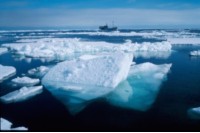The Barents Sea
 Large parts of the Barents Sea are frozen in winter and only the southernmost part towards the coast of North Norway and Russia remains ice-free throughout the year. As the summer gradually creeps northwards, the Barents Sea ice thaws, and animals and birds follow the ice edge northwards.
Illustration: Sebastian Gerland, NP
Large parts of the Barents Sea are frozen in winter and only the southernmost part towards the coast of North Norway and Russia remains ice-free throughout the year. As the summer gradually creeps northwards, the Barents Sea ice thaws, and animals and birds follow the ice edge northwards.
Illustration: Sebastian Gerland, NP
The Barents Sea is an important and large part of the Norwegian Arctic. It stretches from the coast of north Norway in the south to the Arctic Ocean in the north and is bounded by Svalbard in the west and Novaya Zemlya in the east. The Barents Sea is more than four times the size of Norway and is a productive area because it is comparatively shallow, only 230 metres on average, and because it is here that the cold water from the Arctic Ocean meets the warm Atlantic water that is being carried northwards by the Gulf Stream.
Few other maritime areas can boast a corresponding wealth of breeding seabirds. At least 20 million are resident in the Barents Sea in summer. They range over 40 different species and occupy 1600 breeding colonies. This enormous wealth of birds is a result of them finding plenty of food in the form of fish and plankton. Many of the fish that grow up in the Barents Sea have come here as eggs and fry drifting in the ocean currents from spawning grounds further south, and the Barents Sea is totally dependent upon this supply to maintain its productivity.
Did you know...
 A treaty (a binding agreement between nations), the Svalbard Treaty, was signed in 1920 by Norway, the USA, Denmark, France, Italy, Japan, the Netherlands, Sweden, Great Britain and Ireland, and the British Overseas Dominions. The Svalbard Treaty states that Norway not only has the right, but also an international obligation, to ensure that the natural environment in Svalbard and associated areas is preserved and is not destroyed as a consequence of human pressures.
A treaty (a binding agreement between nations), the Svalbard Treaty, was signed in 1920 by Norway, the USA, Denmark, France, Italy, Japan, the Netherlands, Sweden, Great Britain and Ireland, and the British Overseas Dominions. The Svalbard Treaty states that Norway not only has the right, but also an international obligation, to ensure that the natural environment in Svalbard and associated areas is preserved and is not destroyed as a consequence of human pressures.